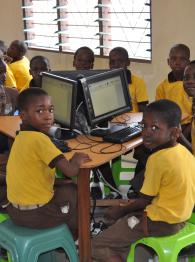
About the Project
This project is one of the 2012 WISE Awards finalists.
Omega Schools is a chain of low-cost private schools serving poor communities in Ghana. An innovative “pay-as-you-learn” daily all-inclusive fee model fitted in with poor parents’ daily cash flow, enabling many who otherwise felt they could not afford private education, even though they desired it, to avoid the need to save sufficient funds for termly fees. The cost of sending a child to an Omega School is hardly more than sending a child to a government school, where all extras have to be provided.
Context and Issue
The inspiration for Omega was research showing burgeoning low-cost private school markets around the world, affordable to parents on minimum wages. Children had higher achievement in low-cost private schools than in public schools, after controlling for socio-economic background. The realization was that quality in low-cost private schools could be further improved, and access extended, through the creation of a chain of schools, where economies of scale and the ability to share information would enable dramatic quality improvements to be made while still keeping fees as low as, or lower than, existing low-cost private schools.
Solution and Impact
This innovation, coupled with the improvements made through lesson plans, pupil workbooks, computing applications and dedicated teacher/management training, has made Omega Schools popular with parents, demonstrated by the fact that a new school is typically full within 10 days of opening. Each school is thus self-sufficient almost from day one. The chain has already demonstrated financial sustainability. It is now in a position to demonstrate scalability through an innovative social franchising/licensing model.
Girls make up 52 percent of enrollment and all pupils are from the lowest two income quintiles. A partner hardship fund extends access to orphans. Its first school opened in September 2009.
Future Developments
By 2021 it aims to serve 200,000 students and demonstrate a workable, scalable, sustainable and replicable model of how to extend access to high-quality, low-cost education for low-income families across the world.